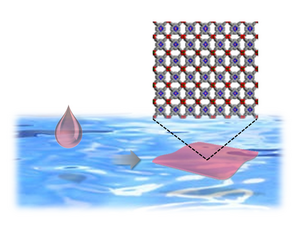Signaling significant advances in the development of separation membranes for high-purity gas recovery and of sensing materials for hazardous gas detectors
Osaka Metropolitan University
image: A solution containing the component materials is dropped onto the water surface, immediately forming MOF nanosheets of exceptional quality. view more
Credit: Rie Makiura, OMU
Rie Makiura, Associate Professor at the Graduate School of Engineering, Osaka Metropolitan University has published a review article on the simple synthesis of nanosheet materials endowed with high-precision nanoscale pores. Nanosheets are two-dimensional materials with nanometer-scale thickness (10-6 mm), attracting attention as ultra-thin functional units suitable for minimizing the amount of material used and miniaturizing products.
Metal-organic frameworks (MOFs) are porous materials with precisely defined pores of nanoscale size and shape; they display excellent molecular adsorption and separation abilities coupled with selective molecular recognition. Their potential as high-performance adsorbents derives from their larger surface area compared to that of conventional materials like activated carbon and silica gel. MOFs can perform a variety of functions and are actively being studied as components in a wide range of fields, including drug delivery and catalyst applications.
The availability of MOFs in nanosheet form is also expected to be utilized in high-performance gas separation membranes and gas sensors; however, to date, developing effective synthesis methods of MOF nanosheets has been a significant challenge.
A research group led by Professor Makiura succeeded in producing the world’s first MOF nanosheets on the surface of water by adding drops of a component material solution onto the surface; the results appeared in press in 2010. The publication announcing the discovery has attracted a lot of attention from scientists worldwide, accumulating more than 600 citations to date. The group has also successfully fabricated organic nanosheets called hydrogen-bonded organic frameworks (HOF) in 2017 and MOF nanosheets, which conduct electricity in 2021 with the same methodology.
In her present review article, Professor Makiura describes in detail the MOF nanosheets developed by her research group, the characteristics of the various MOF nanosheets reported by researchers around the world, and their comparison, as well as their formation mechanism on the water surface.
“I feel honored to be given the opportunity to publish this review article as a leading researcher in the field,” said Professor Makiura. “I hope this review article will accelerate technological progress in the application of MOF nanosheets to separation membranes and in the miniaturization and performance enhancement of sensors.”
###
About OMU
Osaka Metropolitan University is a new public university established in April 2022, formed by merger between Osaka City University and Osaka Prefecture University. For more research news visit https://www.upc-osaka.ac.jp/new-univ/en-research/research/ or follow @OsakaMetUniv_en and #OMUScience.
Coordination Chemistry Reviews
10.1016/j.ccr.2022.214650
Literature review
Not applicable
Creation of metal-organic framework nanosheets by the Langmuir-Blodgett technique
22-Jun-2022
Disclaimer: AAAS and EurekAlert! are not responsible for the accuracy of news releases posted to EurekAlert! by contributing institutions or for the use of any information through the EurekAlert system.
Media Contact
Jens Herzog
Osaka Metropolitan University
koho-ipro@ml.omu.ac.jp
Osaka Metropolitan University


Copyright © 2022 by the American Association for the Advancement of Science (AAAS)
Copyright © 2022 by the American Association for the Advancement of Science (AAAS)




